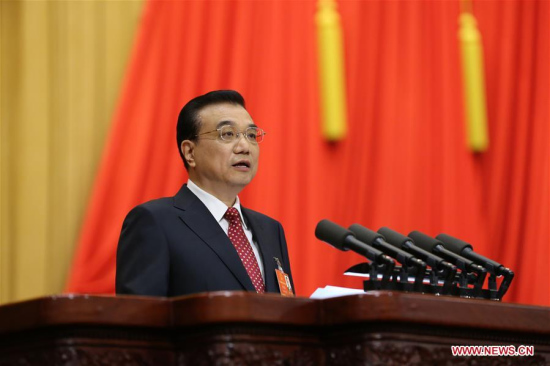
Chinese Premier Li Keqiang delivers a government work report during the opening meeting of the fourth session of the 12th National People's Congress at the Great Hall of the People in Beijing, capital of China, March 5, 2016. (Photo: Xinhua/Liu Weibing)
China announced a raft of growth-supportive measures on Saturday that include investment in infrastructure and an emphasis on innovation to prevent the economy from falling too quickly this year. [Special coverage]
According to a government work report delivered by Premier Li Keqiang at the annual parliamentary meetings, China will invest 1.65 trillion yuan (2,530 billion U.S. dollars) on road construction and 800 billion yuan on new railways.
Other investment for the year includes 20 water conservation projects and projects ranging from hydropower and nuclear power to urban rail transit and urban underground pipelines.
Though such concentrated investment might give the impression China is returning to the old strategy of investment-led growth, the premier gave his reassurance that they are effective investments.
China is working to transition to self-sustaining growth, a departure from wasteful investment fed by unbridled credit expansion. A more efficient network of roads and better use of clean energy fit the ambition.
Investment will also go toward sophisticated projects such as deep space exploration, aero-engine and robot development. China's expenditures on research and development in the next five years will be 2.5 percent of its gross domestic product, up from 2 percent last year, according to the draft 13th Five-Year Plan unveiled the same day.
Following 6.9-percent economic growth in 2015, China set this year's target in the range of 6.5 to 7 percent. Bloomberg said this is "testing but achievable."
The fiscal and monetary policies are becoming more accommodative. This year's budget deficit-to-GDP ratio was raised to 3 percent, up from 2.3 percent last year. The growth of M2, a broad measure of money supply that covers cash in circulation and all deposits, was proposed to be 13 percent, one percentage point higher than last year's target.
Based on China's economic size last year, a rise of 0.7 percentage point in the deficit translates into an extra 470 billion yuan at the government's disposal. Central bank officials said last week that it will implement a prudent monetary policy with "an easing bias."
Stephen Roger, senior fellow at Yale University's Jackson Institute for Global Affairs, told Xinhua that China has "ample fiscal space" to increase its budget deficit, and it is "both wise and prudent to minimize risks by taking out insurance in the form of proactive fiscal policy."
A wave of job losses is on the horizon as China works to slim down its inefficient state-owned enterprises, and this year's crop of college graduates is estimated at around 7.7 million, so adequate economic expansion and job creation are needed to prevent social instability. The 6.5 to 7 percent growth rate can generate enough new jobs, according to Li.
Analysts have urged using the budget increase wisely. Liu Shangxi, director of China Fiscal Science Institute, said the increased budget cannot be used simply as bailout money for "zombie enterprises."
"The temporary fiscal easing offers China a window to facilitate structural reform, which is its top priority," Liu said.
Aside from these investment plans, Premier Li reiterated that China will continue with supply-side structural reforms and foster new growth engines through innovation and entrepreneurship.
The government will set up some state-level innovation platforms this year, Li said.
Supply-side reforms seek to advance economic restructuring by reducing ineffective and low-end supply, and boost productivity by expanding medium and high-end supply,
"Supply-side structural reforms mean both challenges and opportunities for enterprises. By aligning our production with what the market really demands and putting a higher premium on better products and services, we can avoid the fate of elimination by the market," said Liang Fengyi, president of Guangdong Real Faith Enterprise Group Co., Ltd. and a deputy to the National People's Congress.
With increased investment in research and development, the Foshan-based private enterprise specializing in LED lighting products is unfazed by the economic headwinds. Its deep-water fishing lamps, a new product line, have received many orders from Southeast Asia, Liang told Xinhua.
China's emphasis on innovation-driven growth has cheered global investors as it ushers in more opportunities for cooperation.
"The United Kingdom offers a mature, proven system to promote innovation, and our two countries can take cooperation to a new level here," Jeff Astle, executive director of the China-Britain Business Council (CBBC), told Xinhua.
CBBC will hold a forum on "Innovation and Entrepreneurship Education" this month in the port city of Tianjin and will release a report on the Made in China 2025 Initiative for UK companies to work with Chinese companies.
Analysts have also advised patience. Improving supply-side quality and efficiency is a long-term process and we should not expect to see the benefits immediately, CBBC said.
"Innovation doesn't work the way low-cost manufacturing does. Innovation cannot be legislated. An innovation-based economy must accept failure as a necessary part of the process," Robert Lawrence Kuhn, an international corporate strategist, told Xinhua in an e-mail.
"Dramatic changes cause pervasive problems, and China is confronted with contradictions and challenges. The most effective and robust policy to facilitate China's transition is greater competition," Kuhn said.


















































